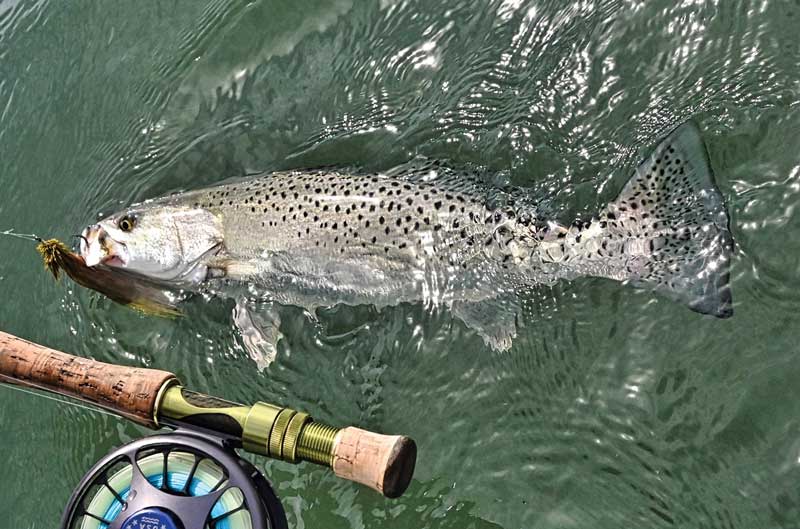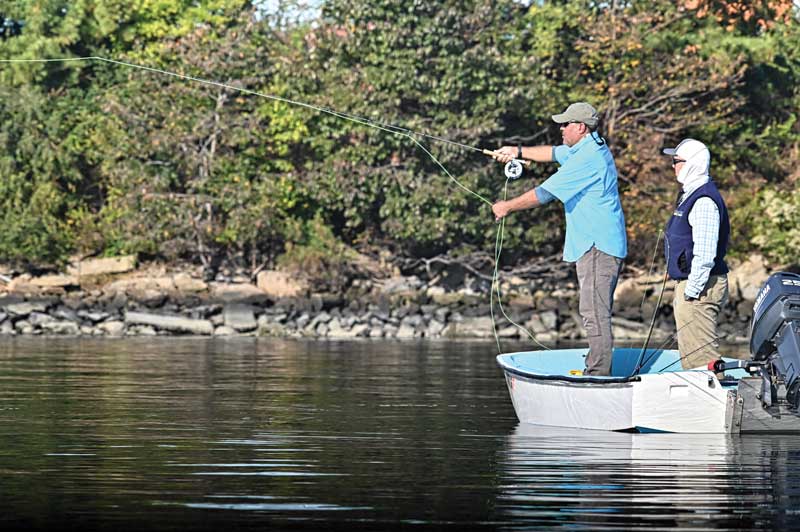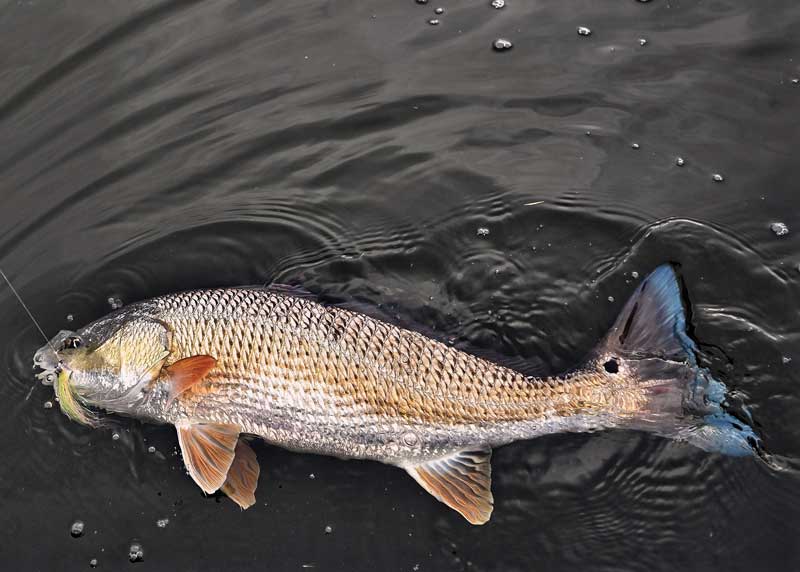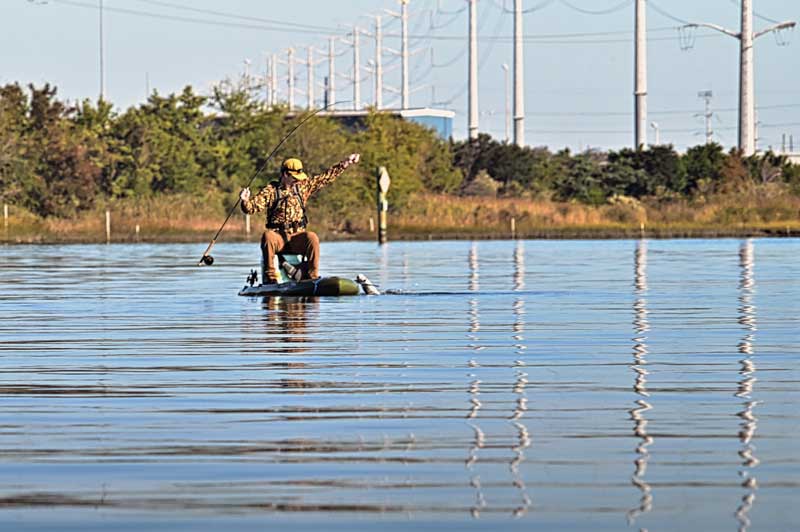It is not a pristine waterway by any means. The Elizabeth River, with its deep natural channel, has been a busy commercial port for generations. Piers and tugboats and concrete abound. However, if you don’t mind fishing around all that commerce, you will find the Elizabeth to be a fantastic fishing hole. This is especially true for speckled trout in the winter.

Norfolk was settled by Europeans in 1636. It quickly grew into a major seaport. Local products were exported to all parts of the world from Norfolk. Shipbuilding became big business. The USS Merrimack was converted into the ironclad CSS Virginia here in 1862. By the late 1800s, the city was known for its large coal exporting operations. Dominion Energy built a coal-fired power plant on the river’s southern branch.
That power generating facility operated until the end of 2014. During its years of use, the plant discharged warm water into the Elizabeth, creating a thermal refuge of warm water for wintering fish. What was called “The Hot Ditch” put the Elizabeth on the map as a major speckled trout hole. Thousands of trout, many of trophy size, congregated in the area.
Back when the power plant closed, I asked Lewis Gillingham, director of the Virginia Saltwater Fishing Tournament, if the fish would leave when the hot water was turned off. He said, “No. The fish will continue to winter there, just like before.” He was right.

Another reason the Elizabeth is so productive is its improving water quality and fishy habitat. In 1991, The Elizabeth River Project was formed at a kitchen table, with the goal of turning a dying urban river into a healthy one. The results have been nothing less than incredible. In addition to a healthy fish population, the river today supports a variety of wildlife including oysters, eagles, ospreys, minks, and even otters right in downtown Norfolk.
From late fall into early spring, fish congregate in the back waters of every branch of the Elizabeth. The most popular area is the former Hot Ditch, from the Gilmerton Bridge all the way back into Great Bridge. The easiest way to find the fish is to look for other boats. This is a popular spot, and there are almost always others fishing in the area, especially if the fishing and weather are good. The schools of trout are readily visible on side scan and live-scope sonars. And remember to be polite. Don’t invade someone’s spot.
Winter specks will hit bait, artificials, and flies. For artificials, be sure to have some suspending plugs. When it is cold, you must fish slowly. Very slowly. Sometimes you just suspend and twitch. Watch the anglers around you for clues. Everyone has a different opinion on colors. As for flies, large flies that suspend are a good choice.

Most anglers use light spinning and casting outfits. You can cast farther if you spool with light braid and then attach a mono or fluorocarbon leader to the end of your line. Anglers who like to switch baits on a regular basis attach small snaps to the end of their leaders. This allows for almost instant lure changes. Fly anglers use six to nine weight rods with a matching intermediate line. The nine-weight is overkill for this fishery but comes in handy when you have to toss large flies.
And it’s not all trout. Redfish and rockfish also call the river home, especially in the winter. Redfish make impressive marks on side scans and live scope sonars. The reds are usually not as picky as the trout and will often eat anything you throw at them. They will hit the same lures you use for trout. Stripers are a bonus that are caught on a regular basis by those fishing for trout and reds.
A lot of the trout spread out into the Chesapeake Bay as waters warm in the spring. However, many redfish and stripers remain and can be caught year-round. The redfish schools usually break up in the summer, so instead of fishing sonar targets, a better tactic is casting to favorite structures. Points, oyster reefs, piers, and just about any structure attract these fish. Fishing at low light, dusk through dawn, is usually much more productive than fishing during the heat of a hot day. Summer is also a good time to fish with bait. There are favorite spots that hold reds all summer, but the fish may not be aggressive. They might ignore your grub but cannot refuse a live minnow fished under a bobber.

Summer also brings spot and croaker. They are often found everywhere. This is a good time to introduce children to fishing because the bite can be non-stop. The easiest way to catch these panfish is with a simple two-hook bottom rig baited with fishbites. The spot really turn on in the late summer, especially during periods of northeast wind.
You can access the river from several locations. One of the most popular ramps is at the Elizabeth River Park, literally under the Jordan Bridge. This ramp is right off Interstate 464 in Chesapeake. There are additional ramps in Great Bridge (Chesapeake), Portsmouth City Park, and in Norfolk at the Haven Creek ramp on the Lafayette River. There are additional kayak-only launch sites in the area.
By far the best way to keep up with what is biting where is through social media. If you search for “Virginia Inshore” or “Elizabeth River” with “fishing,” you will find groups that post reports on a regular basis. Some posters don’t bother to hide backgrounds in their photos, so you can easily identify their location.
And remember to fish safely. The Elizabeth is frequently busy. Tugs and barges are everyday sights. You might even encounter a floating city, also known as an aircraft carrier. These vessels can’t leave the channel to avoid a small boat. It takes them a long time to stop. Be sure to give them plenty of room.
By Kendall Osborne